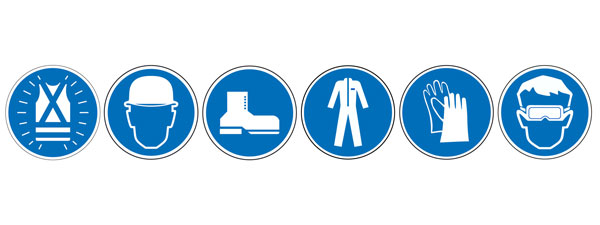All traffic control workers should wear personal protective equipment at all times while in the field to prevent injury and to increase overall visibility to motorists and other workers. It’s not only a good work zone practice, but is always required, and can lead to fines or work stoppages if a worker is caught without properly wearing their personal protective equipment (PPE).
The following is a list of essential PPE for traffic control, however, there may be additional requirements in your specific area that should be reviewed and followed before working on the roadway.
Class-3 Retroreflective Safety Vest
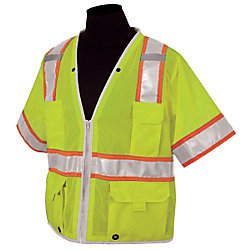
The most important piece of safety equipment to use while working on any roadway is the retroreflective safety vest. These vests are light-weight, allow for a full-range of movement and provide a high-degree of visibility to motorists and other workers while outside the protection of a work vehicle.
The importance of this one piece of safety equipment cannot be understated. If a motorist cannot see you, or tell you apart from another piece of equipment in a work zone, then your chance of being hit greatly increases. Always wear one.
The best type of current vest to wear for traffic control is a Class-3 retroreflective vest with a Lime-Green or yellow base color. Retroreflective means that light emitted from headlights will be reflected back to the driver at the same angle it was received, showing them a very bright reflection of your current location. The bright-fluorescent coloring also gives greater visibility during daylight hours.
The Class-3 part of the description relates to the total amount of reflection on the vest. The higher the type, the better the visibility. Other types of safety vests such as Class-1 and Class-2 just don’t provide the same level of protection necessary for working on the roadway.
Finally, always use a lime-green or yellow safety vest, because these colors allow you to stand out from other objects in a work zone, which are usually orange in color. You don’t want a motorist or other worker mistaking you for an orange barrel.
MSA-Approved Hard Hat
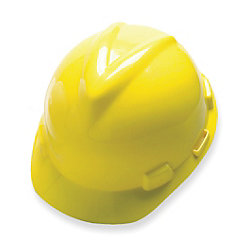
Hard hats are kind of like wearing your seat belt. It feels strange at first, but after awhile you don’t even notice it anymore, and eventually it feels strange not wearing one. And, just like seat belts, hard hats are a necessary part of personal protection that requires minimal effort to use.
Even though it might not always be apparent why a hard hat is required while doing traffic control, because it can often seem that there aren’t any overhead hazards, it’s still a mistake not to wear one for many reasons.
If you’ve ever been driving along in a car and had a piece of rock hit and crack your windshield that was kicked up by a truck or other vehicle in front of you, it should be fairly evident what can happen to your head if a similar piece of rock or debris hits it. There are other more common types of head bumps that can happen on a regular basis while doing traffic control, such as a sign falling backwards onto your head if you miss setting it properly in a sign stand, or even sign stands falling over in a truck onto your head, which are usually stacked standing up. As the old saying goes: “It’s always better to have it and not need it, than to need it and not have it.”
The final reason to wear a hard hat, is for increased visibility in the work zone. Wearing a brightly colored hard hat—and, even better, one that has been modified with pieces of retroreflective striping—can make you stand out even more to motorists.
For the DIY crowd out there, retroreflective stripes are sold in rolls at most hardware and automotive stores. Or, you can ask around at your local sign shop that makes highway signs for pieces of scrap material, which can be purchased dirt cheap, or more-often-than-not given away, if you ask.
Feel free to design away with your favorite sports team logo, company graphic, or just plain old stripes and patterns. As long as you aren’t compromising the functionality of the hard hat, anything that gives you higher visibility in a work zone makes you much easier to see and therefore safer.
Steel-Toe Work Boots
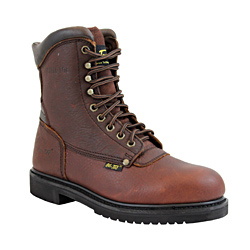
If you can’t walk, you can’t work. It’s that simple. Foot protection is one of the most basic safety practices for almost all types of physical labor and should be a “no brainer” for traffic control work, as well.
Many of the signs, stands, and equipment used in traffic control can cause serious injury if dropped onto your feet and toes. Therefore, buy a good, comfortable pair of steel-toe work boots from a quality manufacturer that also has a solid tread for grip and to protect from punctures.
Buying cheaper boots may make sense in the short-term, but lower-quality boots tend to wear out quicker, are less comfortable to wear, and will wind up costing you more money in the long-term because these boots need to be replaced more often.
Think of a pair of steel-toe boots a good investment that you and your feet will appreciate everyday.
Eye Protection
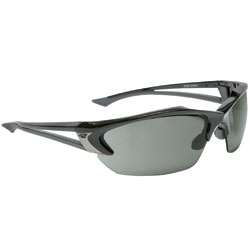
Eye protection is another critical piece of safety equipment that is often overlooked for traffic control.
Like a hard hat, many people feel that the risk of injury is just too low to justify wearing. This is fairly big mistake for workers to make considering that debris and dust often get kicked up from the roadway by passing motorists and somehow always manages to find its way into your eyes.
There are many other dangers, as well, like metal equipment shedding pieces of rust into your eyes, and things like high pressure hydraulic lines, used to install sign posts along with a post-pounder, that can rupture, spraying fluid in many directions.
There are just too many unforeseen hazards out in the field that can cause life-long eye injury to justify not wearing basic eye protection. Considering how cheap protective glasses are—in a wide range of comfortable styles, colors and lens shading—it’s foolish not to use them at all times.
Work Gloves
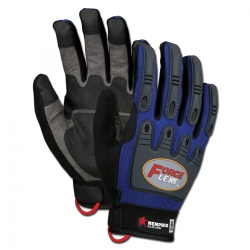
Work gloves are another “must have” for traffic control. Your hands, like your feet, allow you to do your job, and causing injury to either means you won’t be able to work.
Plastic barrels and 42″ cones are manufactured by sealing two halves together with a seam. That seam is often fairly sharp and can cut your hands when handling, especially when picking up cones or barrels over long stretches of road, which can also lead to blisters.
Sign stands have many moving parts that can catch fingers and skin, and also wing nuts that can rust over time making them difficult to turn bare-handed.
Metal highway signs may have sharp edges or burrs that can slice open your palm, especially if you are loading or unloading them more than two at a time, because the ones sandwiched in the center have a tendency to slip and slide and can easily slice open an unprotected hand. Other equipment may have rough or rusted textures that can cause scrapes, scratches, and blisters.
Therefore, it’s always a good idea to use properly fitted work gloves when handling traffic control equipment. Use a lighter, well-ventilated pair of gloves offering good hand protection during warmer times of the year, and heavier, insulated gloves in cooler months.
Work Clothes
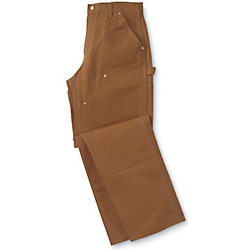
Dressing appropriately for traffic control work is another requirement for working safely in the field.
Always wear a brightly colored shirt under your Class-3 vest, and even a long-sleeve shirt or jacket with retroreflective striping built into the sleeves during cooler weather.
Sturdy work-pants provide an immense amount of protection for your legs and should be chosen carefully to find a pair that is comfortable and will stand up to a lot of abuse. Standard blue jeans are ok to use, but sturdier canvas work pants offer far better protection.
Lighter colored pants will also keep you cooler during warmer times of the year by reflecting away more heat. Some manufacturers even offer built in retroreflective striping that runs down the outside of each pant leg for increased visibility.
Much of the equipment that is used for traffic control can cause serious scrapes, bruises and cuts to your legs. For example, the bases used for 42″ cones are usually made from recycled tires that have been ground up and pressed into a heavy block that the plastic cone slides into. These bases have a rough texture, almost like sandpaper, and the corners are fairly sharp, which can easily scrape your skin if one bangs into your leg.
For many types of orange barrels, the side-wall section of recycled steel-belted tires are used as the base to anchor the barrel to the road, and the outside edges of these rings are very sharp with protruding steel wires that will quickly slice an unprotected leg if it makes contact.
Therefore, never, ever wear shorts for traffic control work. The risk of injury to exposed skin is just too high and will never be allowed for any reason by the traffic engineer.

